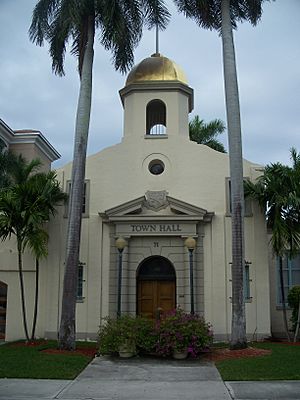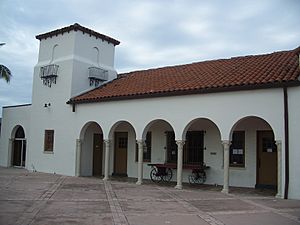Boca Raton Historical Society and Museum facts for kids

Boca Raton Historical Museum located in Old Town Hall
|
|
| Abbreviation | BRHS&M |
|---|---|
| Formation | 1972 |
| Type | Historical Society |
| Headquarters | Boca Raton Old City Hall |
| Location |
|
|
President
|
Hank Jawhari |
The Boca Raton Historical Society & Museum (also known as BRHS&M) is a special place that helps keep the history of Boca Raton, Florida alive. It's a non-profit group and a public museum. Their main job is to collect and protect old items and stories from Boca Raton. They also teach people about the city's past.
A big goal of the society is to save and restore important old buildings in Boca Raton. They offer many ways to learn, like exhibits, talks, and history tours. They also have fun educational programs for schools, teachers, and kids. This helps young people learn about Florida's history. The society has a library full of old photos, newspapers, diaries, and books for anyone who wants to research. They even help scholars and students with their research. You can visit the Boca Raton Historical Museum from Monday to Friday, 10 AM to 4 PM.
The society and museum are located in the Boca Raton Old City Hall. This building was finished by architect William Alsmeyer. The society itself was started in 1972 by a group called the Junior Service League. The society also runs the Boca Express Train Museum. They helped restore the old Florida East Coast Railway Station, which is now called the Count de Hoernle Pavilion. You can take tours there to learn about its history. The historical society also hosts a yearly food and wine festival called the Boca Bacchanal to raise money.
Contents
History of the Society
The Boca Raton Historical Society began in 1972. It was a project started by the Junior Service League. They wanted to create a local history museum in the Old City Hall. Just two years later, the society led a big project to protect important buildings in Boca Raton. These included the Old City Hall, the Cloister Inn, the Mizner Administration Building, and the Florida East Coast Railway Station. These places were saved from being torn down because they were historically important.
Over the next ten years, the society worked on many restoration projects. They helped restore Singing Pines (which became the Children's Museum). They also moved the Cabana Club and worked on the Boca Raton Old City Hall and the F.E.C. Railway Station. In 1975, the city council decided that the Old Town Hall would become a historical museum. The society started restoring the Old Town Hall in 1983. By November 1984, the restoration was finished. They received over $500,000 in donations for this work. The project even won an award for historic preservation!
The Train Station's Story
In 1985, the city bought the Florida East Coast Railway Station. The Boca Raton Historical Society was then asked to raise money and manage its restoration. The society did an amazing job! They raised almost $1 million. This included donations from the community, a state grant, and a large donation from Countess de Hoernle in 1986. Because of her generous gift, the train station was renamed the Count de Hoernle Pavilion.
A year later, the society's members restored four old railway cars. These included a 1930 locomotive and caboose, plus two sleek rail cars from 1947. Two years after the restoration, the society won another award for their work on the train station. By 2004, the inside of the Boca Express Train Museum was finished. It then opened to the public for the first time.
What the Society Does
The Boca Raton Historical Society works to collect, protect, and share information and items about Boca Raton's past. They also play a key role in teaching people about history and saving old buildings in the community.
History Exhibits
The society has many exhibits, including some you can see online. These include "1909 Boca Raton," "Mizner's Dream," and "Pearl City." They also have a new exhibit at the Town Hall called History Alive!
Guided Tours
The historical society offers several tours. You can visit the Boca Express Train Museum or the Historic Town Hall. They also have a special Halloween walking tour at the Boca Raton Cemetery. You can even take virtual tours of Old Town Hall and other historic places in Boca Raton from your home.
Learning Programs
The society has a program for elementary schools called Ticket to Ride. This program takes students on history tours of the Boca Express Train Museum. It helps students learn about history and prepare for important tests.
They also offer free lessons about Boca Raton's local history. These are taught in local schools and are available online. For scouts, there are Tours for the Scouts. Scouts can visit Town Hall or the Boca Express Train Museum. These visits help them earn history badges.
Boca Bacchanal Event
The historical society hosts a big food and wine festival every spring called the Boca Bacchanal. It's their main event for raising money. Many famous chefs and wine experts attend, and over 2,000 guests come each year. All the money raised helps the Boca Raton Historical Society. This allows them to create more educational programs for students, residents, and visitors. The festival has been a major fundraiser since it started in 2003.
Walk of Recognition
Since 1997, the society has honored people and groups who have made a big difference in Boca Raton. This event is called the Walk of Recognition. People are nominated by the public. A group of judges then chooses those who have been important community leaders. The names of those chosen are carved into black granite stars. These stars are displayed at Royal Palm Place. Every November, an event is held to celebrate these important figures in Boca Raton's history.
Collections of History
The society keeps many different types of historical items.
Photographs
They have about 16,000 photos showing how Boca Raton grew from the 1900s until today. This includes pictures of old buildings, farms, and the Boca Raton Army Air Field. They also have old aerial photos of Boca Raton that you can compare to new ones.
Manuscripts
The society has collected about 200 manuscripts. These are handwritten or typed documents. They include papers from early farmers and details about places like the Yamato Colony and Pearl City. There are also documents about the Boca Raton Army Airfield during World War II.
Maps
They have about 500 maps of Boca Raton from different time periods.
Newspapers
The historical society keeps copies of old newspapers like the Boca Raton News. They also have copies of The Pelican and Weekly Tattler. Many of these newspapers are now digital and can be seen on their website.
Artifacts
The society protects about 2,000 historical items and souvenirs. This includes items from World War II and even the first IBM Personal Computer invented in Boca Raton. They also have over 150 pieces of furniture and decorations from Mizner Industries displayed in the Old Town Hall. One special item is a Maxwell House coffee can. It was saved from a merchant ship that was attacked by a U-boat off the coast of Boca Raton.
Oral History
The society has about 120 recorded interviews. These are "oral histories" from early residents of Pearl City. Pearl City was Boca Raton's first historical Black community. These interviews helped create the 1990 book Pearl City, Florida: A Black Community Remembers.
Reference Books
The society has about 600 books about Florida's history, preservation, and architecture. They also have academic journals like the Tequesta, The Florida Historical Quarterly, and the Spanish River Papers. The Spanish River Papers is a journal published by the Boca Raton Historical Society itself.
Board Members
- Hank Jawhari, President
- Kirsten Stephenson, Vice-President
- Denise Alman, Secretary
- Loren Mintz, Treasurer
- Bill Lane, Assistant Treasurer
See also
- List of historical societies in Florida


